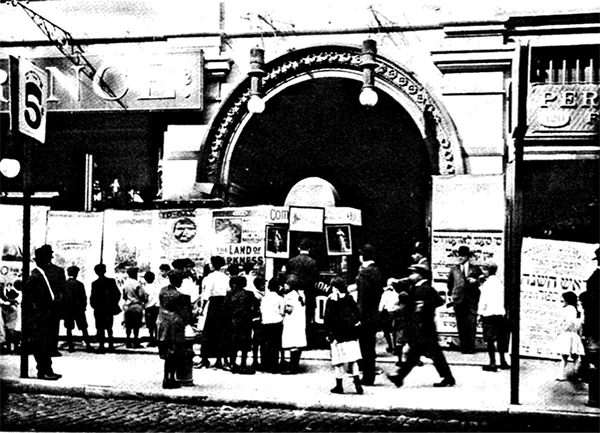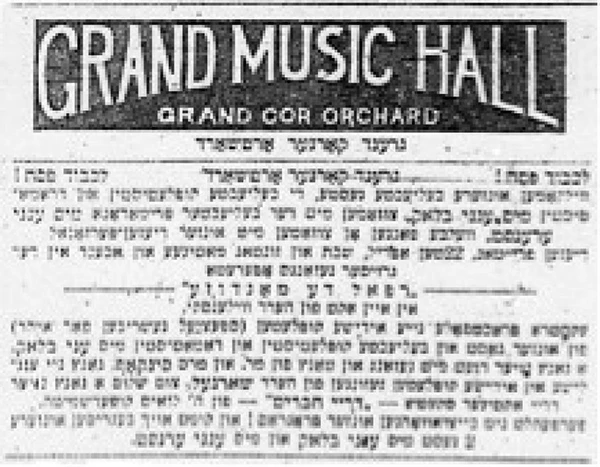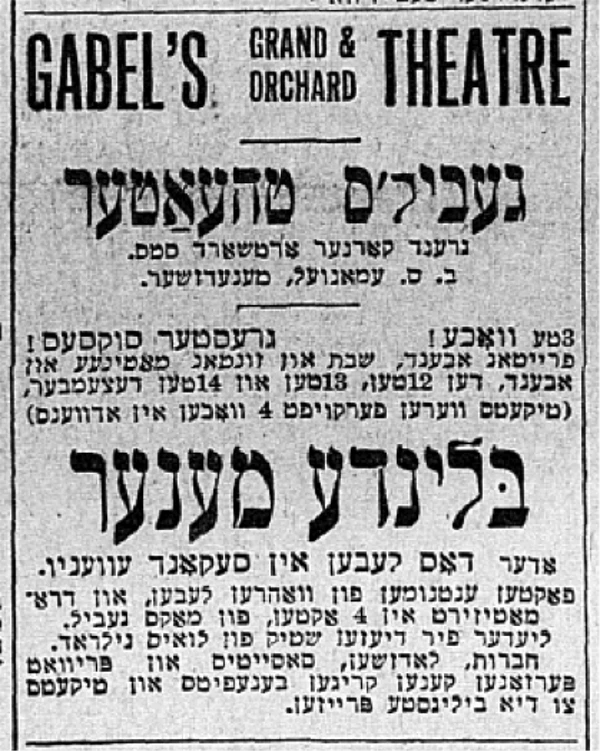Should a Married Woman Visit a Yiddish Music Hall?

“What a strange question,” you might think. Why would it be a problem if someone went to a music hall simply to have some fun? In the early 1900s, the answer was complicated.
In the early days of Yiddish vaudeville in New York City, Jewish immigrants would occasionally visit music halls. Few, however, considered attending vaudeville a respectable pastime. Most people preferred spending their hard-earned cash on a far more expensive evening at one of the legitimate Yiddish playhouses. But why? The Yiddish newspapers published negative commentary about vaudeville. When the first Yiddish concert saloons opened their doors on the Lower East Side in the winter of 1901, all newspapers strongly condemned their vulgar repertoire of bawdy songs, suggestive dances, and risqué jokes. Abraham Cahan, the editor of the Jewish Daily Forward, called the music halls “a crime against decency.” He was one of fiercest critics of Yiddish variety entertainment. He quoted the song “Vi kumt es Khane” as an example of vaudeville “shmuts” (filth):
Ikh hob zi ibergelozt a meydl a dare
Ober ven ikh bin gekumen tsurik…
Oy, zi iz epes gevorn nor tsu dik…
Khane! vi kumt es, Khane?…
Vi kumt es, Khane?
When I left her, she was a slender girl
But when I came back
Oy, she had become too round
Hannah! How come, Hannah?
How come, Hannah?
Cahan feared that songs like this would corrupt immigrant youth. He also complained that the music halls were “schools for drinking” because customers were expected to order a glass of beer or wine while they enjoyed the free shows.

At first, the anti-vaudeville campaigns were successful. But over the years, more and more Jewish immigrants turned a deaf ear to the warnings in the press. It helped that the music halls managers began to charge entrance fees, thus dissociating their shows from the obligatory consumption of alcohol. They also renovated their halls or moved into larger ones, offered more elaborate stage shows, and incorporated the latest novelty in their programs: moving pictures. By late 1905, Yiddish vaudeville had become a booming business on the Lower East Side and in Brooklyn.
The transformation of Yiddish music hall shows was so successful that it actually threatened to replace “legitimate” Yiddish theatre as the most popular entertainment for New York Jews. As a result, the guardians of immigrant morality and good taste were scandalized. With renewed vigor, Abraham Cahan railed against Yiddish music halls for weeks in the winter of 1905-1906, turning his fight into an issue over labor. According to the Forward, it was up to the members of Hebrew Variety Actors’ Union to take the necessary measures to enforce respectability in the music halls. This attack on the actors aroused a storm of protest led by the vaudeville star Fanny Reinhardt. In a letter to Cahan in December 1905, she asked, “Who is responsible for the immoral songs?” According to Reinhardt:
In every Yiddish music hall, burlesque songs are received with warmer applause than serious ones… I have often sat in the audience, listening in on conversations. Once, when an actor on the stage performed a plain, earnest, lovely, and solid song, some people in the audience began to shout ‘order’ instead of ‘bravo.’ Then the comic made his appearance, and his songs, which were full of double meanings, were greeted with a thundering applause.
Reinhardt’s letter, which appeared in a Forward column devoted to labor and union news, shrewdly concluded with an appeal to Jewish workers: “The only thing I want is for the people to judge who is guilty.” Of course, there were bound to be reactions. The newspaper received several letters from readers, and Cahan included some of them in his response to Reinhardt, which he gave the provocative title “Should a married woman visit a music hall?” The answer, of course, was “no.” As long as the vaudevillians did not clean up their acts, Cahan considered it improper for both men and women to patronize the halls, regardless of they were married or not. Many Forward readers undoubtedly agreed with him, but there were obviously many more who frequented the music halls on a regular basis. These workers might well have been disturbed by Cahan’s attacks. A female reader and convinced socialist expressed mixed feelings about his anti-vaudeville campaign: “The Forward is right in criticizing the Yiddish music halls because many are indecent…[but] where should poor people pass their time?”
In reaction to the criticism, Yiddish vaudeville houses publicized the respectability of their establishments and clientele. In the same Forward that discouraged its readers from visiting the music halls—no one was immune to the need for revenue from advertisements—Julius Prince promoted his Grand Music Hall (at the corner of Grand and Orchard Streets) as “a truly honest, new Yiddish variety for Jewish families.” He proudly reported that on opening night “the audience amused itself in the best manner.” His insistence on the fact that the Grand Music Hall was “a beautiful family place,” should come as no surprise. His 1,000-seat venue (a former factory loft) was located right above his father’s liquor store! Prince even appointed actor/manager Morris Heine director to make sure that there could be no doubt about the character of his shows. Heine’s rich experience in the field of the legitimate theatre ensured potential patrons that they would be given “the finest and most pleasant attention.” Of course, all this tells us little about what actually happened on the stage or in the auditorium. The advertisements primarily served to dissociate Grand Music Hall from the controversial image of the concert saloons.
Still, Prince’s publicity campaign did the trick. Men and woman, married and unmarried, young and old, flocked to his Grand Music Hall and enjoyed an evening’s entertainment that cost not even half the price of a gallery seat in Jacob Adler’s Grand Theatre, located two blocks down the street.

Yiddish vaudeville shows flourished until the recession of 1907-1908, when for many immigrants even an outing to a music hall became too expensive. With little money to spend, Jewish audiences embraced the latest craze in cheap entertainment: five-cent picture shows. Yiddish music hall managers did the same. Prince first tried a skating rink, but he soon also switched to muving pikshurs. Yiddish vaudeville almost vanished from the market, much to the satisfaction of critics like Cahan, who considered moving pictures a less offensive amusement for the immigrant masses. However, as soon as the crisis was over, the new management of the Grand Music Hall triumphantly announced that the program would be devoted again to “first class Yiddish variety” with Fanny Reinhardt as leading lady. Short movies stayed on the bill as a “tsimmes to the show.”

Yiddish vaudeville never regained its popularity. Entertainment preferences were rapidly changing: the film era had begun. A few Yiddish music halls remained in business; others were demolished to make room for purpose-built “photo-playhouses.” Moving picture theatres mushroomed across Jewish New York and Cahan’s Forward began to see that they were a much more serious threat for the legitimate Yiddish theatre than the vaudeville shows had ever been. For the Grand Music Hall, the curtain fell in January 1914, when a new building code imposed more stringent safety regulations and prohibited live entertainment in make-shift theatres. The last star on its stage was Max Gabel. The venue remained open for another year showing moving pictures, but after several fines for “unlawful use” of the premises, it was turned into a fight club and then a furniture store. Today the building is still there (316-320 Grand Street), but nothing reminds us of its rich and turbulent history as a Yiddish music hall.
Article Author(s)
